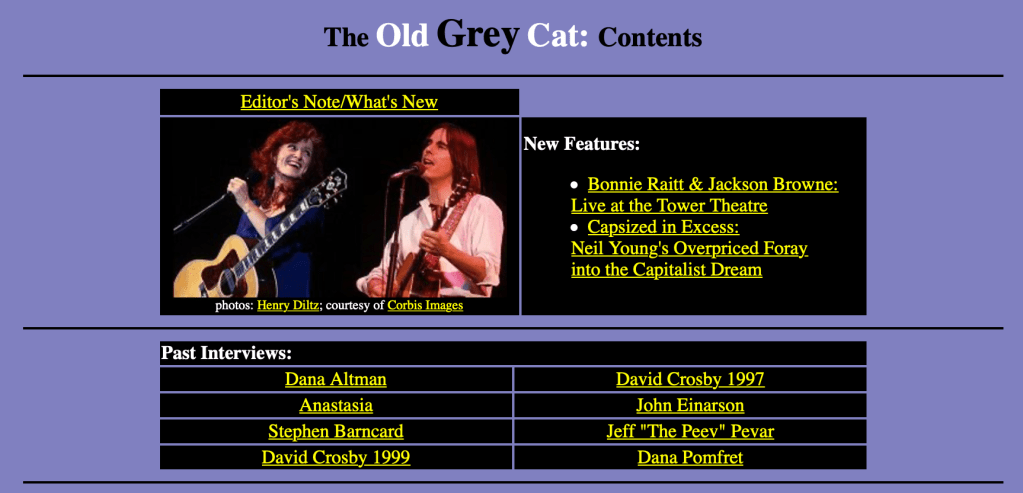This month marks not one, but two noteworthy anniversaries within my online life: In February 1997, Diane and I launched the original Old Grey Cat website on GeoCities; and 15 years later, in February 2012, I joined the blogosphere via the Hatboro-Horsham Patch. I’ll save the latter for later this month, and focus on the former today and next weekend.
Diane and I first traveled the electronic highway in the dirt-road days of 1991 on our IBM clone, prowling Prodigy’s message boards and trading tapes, making acquaintances, making friends. It was fun, if frustrating, due to the sometimes byzantine business practices Prodigy employed, such as charging per message and, later, by the hour. One could also access the World Wide Web, as it was known, but only through the Prodigy interface – which wasn’t that good. Then, sometime in the fall of 1996, offline friends who’d just made the jump to an ISP and Netscape Navigator introduced us to the Web proper.
Our minds were blown.
Within a few months, we shed Prodigy in favor of Erol’s Internet – and staked a claim on the Web thanks to GeoCities, where we “homesteaded” in the Towers section of the SunsetStrip subdivision. (For those unfamiliar with GeoCities, it was the WordPress.com of its day, providing free server space and a URL in exchange for modest advertisements on each page. And, just like WordPress, it provided an option to upgrade to a unique URL and no ads.)
For that first attempt at a website, I used Microsoft Publisher, a consumer-facing desktop-publishing program that included an option to convert pages into HTML files. We wrote a few reviews, which I then copied over to Publisher, and uploaded everything to the Web. I named the end result The Old Grey Cat – after our old grey cat. (His name was Smokey; he lived on the second floor.)

I also included this statement of purpose: “The aim of The Old Grey Cat is to bring back something that’s been missing from rock criticism in recent years: Passion. Back when the genre was born in the ’60s (via Crawdaddy and Rolling Stone), when you read a review of an album you were generally reading more than just a “thumbs up” or “thumbs down” critique of the music. The writers went one step further and took you inside the music with their own words, reflecting the rhythms, melodies and themes so that the readers could/would get an approximation of what, say, Marvin Gaye’s What’s Going On was about.”

That initial design, I should add, wasn’t very good: Microsoft was all about bucking HTML standards, as it wanted the Web for itself. Which is to say, the site looked as intended when viewed with Internet Explorer, but like a bazooka had made mischief with the layout when Netscape Navigator was used. I switched to Microsoft FrontPage, which did adhere to HTML standards, soon thereafter.
Unfortunately, my digital archives don’t include the original incarnation; I fear it’s been lost to time. (The above images are from sometime in ’99.) But, I did come across this on a backup CDR:
Yep, a page from the first year in which we celebrated all things High Fidelity – Nick Hornby’s novel, that is, not the movie (which wouldn’t hit the theaters for a few more years). Diane wrote the intro.
These were our Top 5 Albums of All Time:
These were our Top 5 Singer/Songwriters of All Time:
And, because the original aim was to be about more than “just” music, these were our Top 5 Novels of All Time (FGS is one of the offline friends who introduced us to the Web):
One present-day observation about the lists: I’ve become much less absolute when it comes to who or what ranks where in the pantheon that is popular music. By and large, it’s all good – and, as Neil Young famously says, “all one song.”
Another observation: Bruce Springsteen would place much higher on both our lists – he’d top Diane’s and place beneath Neil on mine (if I still made such lists, that is). Back then, we’d yet to recover from (and forgive him for) the Human Touch/Lucky Town debacle, not to mention ditching the E Street Band.






Interesting lit lists!
LikeLiked by 1 person